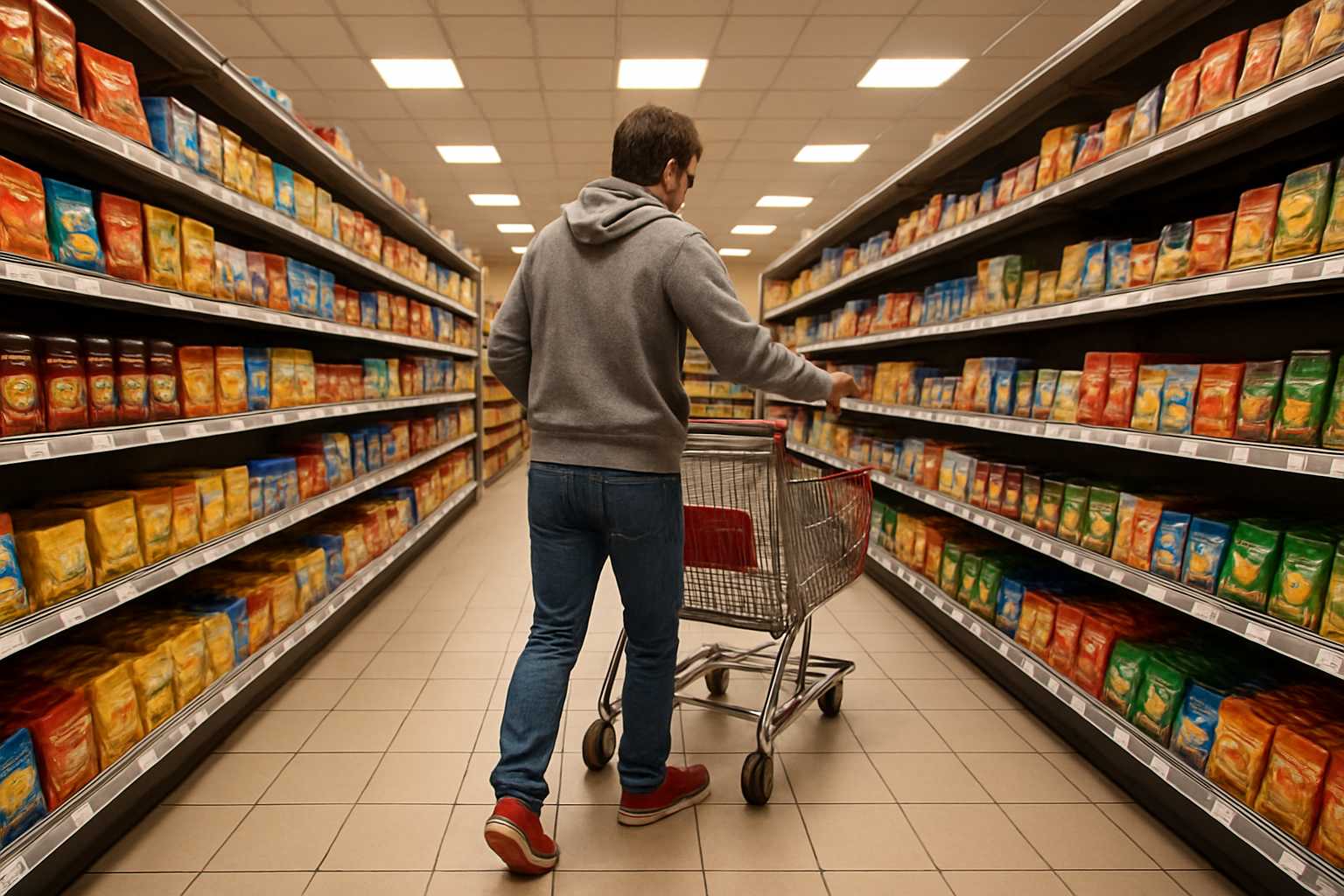Quick Links
ToggleStarting a grocery store might seem simple on the surface, but there’s a lot more to it once you dig in. Over the years, grocery stores have gone from small local setups to large, well-organized spaces that meet the daily needs of entire neighbourhoods. With people depending on them for everything from fresh produce to packaged goods, these stores have become a steady and profitable business option. If you’re planning to start one, it helps to understand what a grocery store is, how it’s different from other retail setups, and what it takes to get started. In this blog, we’ll walk you through all of that in a straightforward way.
What is a Grocery Store?
A grocery store is a place where you can find all the everyday items you need, from food to household supplies. Whether you’re picking up fresh fruits and vegetables, milk and bread, or even basic cleaning products, grocery stores bring everything under one roof to make shopping easier for you. These stores stock a wide variety of products like packaged foods, beverages, dairy items, meats, canned goods, toiletries, and more.
In India, grocery stores are an important part of daily life. They are often the first stop when you need something at short notice. From your friendly neighbourhood kirana shop to supermarket chains and even quick online platforms, they all help make sure your basic needs are met without any hassle. Whether you’re buying your monthly ration or grabbing a quick snack, these stores make life a little more convenient.
Types of Grocery Stores in India
-
Local Grocery Stores / Kirana Stores
These are small, family-run shops you’ll find on almost every street. They usually stock essential items in small quantities. You can even ask for credit or get items delivered to your home, especially if you’re a regular customer.
-
Supermarkets
Supermarkets are larger than kirana stores and offer a better-organized shopping experience. You’ll find a wider variety of brands and products, all neatly arranged on shelves. Most urban areas have well-known names like Reliance Fresh, D-Mart, or Big Bazaar.
-
Hypermarkets
These are even bigger than supermarkets and often combine groceries with clothing, electronics, and more. They are perfect for doing all your monthly shopping in one go. Stores like Star Bazaar or Spencer’s fall into this category.
-
Online Grocery Stores
If you don’t feel like stepping out, online grocery stores have got you covered. Quick commerce platforms like Swiggy Instamart, Blinkit, Zepto, and BigBasket deliver groceries to your doorstep, often within minutes. These services are especially helpful for people with busy schedules or those who prefer the comfort of home shopping.
Read our guide → How Much Does it Cost to Open a Grocery Store?
What Can You Buy at a Grocery Store
Grocery stores in India stock a wide variety of daily essentials. Whether you’re shopping for your kitchen, your personal care, or just grabbing a snack, there’s a lot you can pick up under one roof.
Here’s what you’ll usually find:
- Grains and pulses like rice, wheat, dals, and millets
- Fresh fruits and vegetables, both local and seasonal
- Dairy products including milk, curd, paneer, butter, and cheese
- Spices and masalas that are must-haves in Indian cooking
- Cooking oils such as mustard, sunflower, groundnut, and refined oils
- Packaged foods like biscuits, noodles, chips, and ready-to-eat meals
- Beverages including tea, coffee, soft drinks, and juices
- Personal care items like soaps, shampoos, toothpaste, and razors
- Household essentials such as dishwashing liquids, floor cleaners, and detergents
- Frozen foods including parathas, green peas, nuggets, and ice cream
- Bread and bakery items like pav, sliced bread, buns, and cakes
- Stationery and basic utilities like pens, notepads, batteries, and light bulbs
- Pet food and baby care items depending on the size and type of store
Traditional vs Modern Grocery Shopping in India
Let’s be honest, grocery shopping in India has changed a lot. You might still have your trusted kirana shop down the street, but there are also those big retail chains or even online apps you scroll through while sitting on your sofa. Each one has its way of working.
Let’s explore their differences below:
| Point of Comparison | Organized Retail Chains (Supermarkets) | Local Kirana Stores |
|---|---|---|
| Product Range | You’ll find a large variety of items beyond just groceries. From packaged food, cleaning supplies, personal care items, fresh fruits, frozen foods, and even electronics, everything is available under one roof. | Kirana stores mainly stock food grains, spices, snacks, soft drinks, biscuits, soaps, and other day-to-day use items. The variety is limited but focused on what people buy often. |
| Store Size | These stores are usually big, with organized shelves, dedicated sections for each product type, and enough space for trolleys. Some are part of national or regional chains. | Kirana stores are usually small shops, often run by a single person or family. They operate out of a small space, often just enough to store essentials. |
| Startup Investment | Requires heavy investment due to space, inventory, staff, and technology. These stores often rely on central warehouses and billing systems. | Needs much less investment. Many kirana shops start with basic stock and simple infrastructure. They often run without extra staff or automation. |
| Shopping Purpose | Best suited for customers who want to buy everything at once ranging from groceries, household items, toiletries, and more. Most people visit these stores with a long list. | Ideal for quick visits. Whether it’s a missing vegetable or a packet of salt, kirana stores work best for short, frequent purchases. |
| Product Focus | Offers variety in every category. For example, there might be 10 different brands of rice or multiple types of cooking oil. Many also have bakery items, ready-to-eat meals, and in-house promotions. | Focus is more on fast-moving items. The stock is based on what local customers buy regularly. There might not be too many brands, but the basics are always available. |
| Billing & Systems | Billing is done through computer systems. Customers get printed receipts, and there’s usually support for card or digital payments. Offers and loyalty points are also common. | Billing is mostly manual or on a calculator. Payments are mostly in cash, though UPI and digital options are becoming more common now. |
| Customer Experience | The experience is more structured. You usually get air-conditioned shops, shopping baskets, product labels, discounts, and sometimes even customer support counters. | The service is more personal. Shopkeepers often know their customers by name and may even offer credit or home delivery in the neighbourhood. |
| Home Delivery | Some supermarkets offer delivery via their apps or tie-ups with delivery platforms. However, it may not be as fast as local stores. | Many kirana shops deliver items within the area, often within minutes. It’s all based on local trust and convenience. |
| Location | Found mostly in commercial areas, shopping malls, or as standalone outlets in bigger cities and towns. | Found in every residential locality, often just a short walk away. They are deeply rooted in every neighbourhood. |
How to Start a Grocery Store in India?
Starting a grocery store in India begins with a solid business plan. First, decide your niche. Will you sell everyday items, organic goods, or a mix of both? If you’re opening a physical store, choose a location that gets good foot traffic. Next, take care of the legal side with licenses like FSSAI, GST, and Shop Act. Once that’s done, build partnerships with reliable suppliers to keep your inventory stocked. Don’t forget to invest in basic technology like billing software and a simple store setup to run things smoothly.
Read our guide on → How to Start an Online Grocery Store in India?
Rise of Online Grocery Shopping in India
Online grocery shopping in India is growing faster than ever. With strong digital infrastructure and changing shopping habits, more people are buying groceries online. In 2024, the market hit ₹73,000 crore and is expected to grow at over 31% every year till 2029. Quick commerce platforms like Zepto, Blinkit, and Swiggy Instamart are now handling more than 4 million orders daily. This shows how quickly the market is expanding.
If you’re thinking of starting a grocery business, this is your chance to go online and reach a wider audience. Whether you’re running a local store or just getting started, moving online can help you grow faster and serve customers better.
Closing Thoughts
Grocery stores have become a part of everyday life, whether it’s your local kirana or a big retail chain. If you’re planning to open one, it’s good to know how the industry works. Take your time to plan things well and choose what fits your budget and area. A little preparation can go a long way in building a steady business.
How Grocery Stores Can Go Online With Zopping



